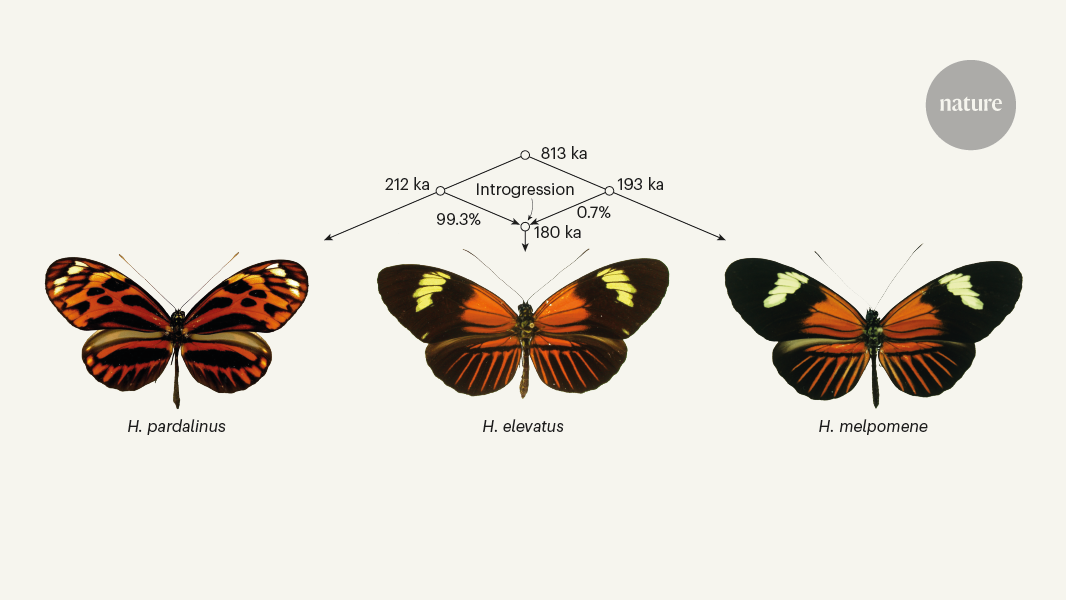Genetic Hybridization Leads to the Emergence of a New Butterfly Species
Core Concepts
Hybridization between different butterfly species can lead to the formation of a new, independent evolutionary lineage and species, even without a genome-doubling event.
Abstract
The article discusses how the flow of genetic material between populations, known as gene flow, can be a powerful force in shaping the biodiversity of our planet. Geneticists often think of gene flow's ability to homogenize and reduce differences between groups, but it can also be a creative process. The introduction of new genetic variants (alleles) into a population through hybridization, or mating between species, can open up new avenues for adaptation.
In some cases, this hybridization can lead to the formation of a new evolutionary lineage and species, even without a genome-doubling event (polyploidy). This is known as homoploid hybrid speciation, and it is a much rarer phenomenon compared to hybrid speciation with genome-doubling.
The article discusses a study by Rosser et al. that provides evidence of homoploid hybrid speciation in longwing butterflies. The researchers have found that hybridization has enabled the formation of a new, independent butterfly species.
Surprise hybrid origins of a butterfly species
Stats
None.
Quotes
None.
Key Insights Distilled From
by Megan E. Fra... at www.nature.com 04-17-2024
https://www.nature.com/articles/d41586-024-00858-3
Deeper Inquiries
How common is homoploid hybrid speciation in the natural world, and what are the key factors that determine its likelihood?
Homoploid hybrid speciation is relatively rare compared to speciation through other mechanisms. The likelihood of homoploid hybrid speciation is influenced by several key factors. Firstly, the genetic compatibility between the parental species plays a crucial role. If the parental species are genetically compatible and can produce viable offspring, the chances of homoploid hybrid speciation increase. Additionally, ecological factors such as habitat overlap and niche differentiation can also impact the likelihood of hybrid speciation. If the hybrid offspring occupy a unique ecological niche or have a competitive advantage in a particular environment, they are more likely to establish a new lineage and eventually evolve into a separate species.
What are the potential evolutionary advantages or disadvantages of a new species formed through homoploid hybrid speciation compared to species formed through other mechanisms?
A new species formed through homoploid hybrid speciation may have several evolutionary advantages. Firstly, hybridization can introduce novel genetic variation into the gene pool, potentially increasing the adaptive potential of the new species. This increased genetic diversity can help the hybrid species adapt to changing environmental conditions or exploit new ecological niches. On the other hand, homoploid hybrid speciation may also come with disadvantages such as reduced fertility or genetic abnormalities due to genetic incompatibilities between the parental species. These factors can limit the long-term viability of the hybrid species and their ability to persist in the face of environmental challenges.
How might the insights from this study on butterfly hybridization inform our understanding of speciation and biodiversity in other organisms, such as plants or vertebrates?
The study on butterfly hybridization provides valuable insights into the role of hybridization in speciation and biodiversity across different organisms. By demonstrating that homoploid hybrid speciation can lead to the formation of a new evolutionary lineage in butterflies, researchers can apply similar principles to study speciation in other organisms such as plants or vertebrates. Understanding the genetic mechanisms and ecological factors that promote hybrid speciation can help researchers uncover the processes driving biodiversity and species diversification in various taxa. Additionally, studying hybridization in butterflies can serve as a model system for investigating speciation patterns and evolutionary dynamics in other groups of organisms, contributing to our broader understanding of biodiversity and evolutionary processes.
0
